Target zero:
how does the UK get to the 2050 emissions goal?
Our viewpoint
12 June 2019
Today the government made a commitment to cut UK emissions to almost zero by 2050. Kyle Martin delves into the recommendations of a Committee on Climate Change report which forms the basis for the announcement.
The government’s commitment to cut greenhouse gas emissons in the UK to almost zero by 2050 has its basis on the recommendations of a report from the Committee on Climate Change (CCC.) The CCC concluded that ‘net-zero is necessary, feasible and cost-effective’ by 2050 and it is these findings that the government’s target is based on. The report received mixed views from commentators - as is to be expected from any report that proposes such significant changes across the economy - but the government’s commitment now means it needs to be delivered.
While fully supporting the ambition of the CCC’s report, I recognise that the recommendations need to be realistic if they are to be credible. Significant lifestyle changes will be required if we are going to meet this target. If the CCC had demanded everyone to become vegan overnight, this would alienate a significant proportion of the public while allowing more criticism of the other sectors that also need to rapidly decarbonise. However, the CCC have set out a number of sensible and gradual changes to our behaviour including a 20% reduction in the amount of beef, lamb and dairy produce consumed, reducing aviation use, switching to low carbon heating and using low carbon transport. Although some of these changes are desirable (I’d happily switch my car for a Tesla tomorrow) others will be more challenging. Changes to the power sector will ultimately be driven by government policy and regulation with the industry largely building the infrastructure needed to decarbonise this sector.
How will the UK economy decarbonise?
Electricity production will continue to play a pivotal role in decarbonising the economy. As the cost of low carbon technologies continue to fall this, will allow heat and transport to decarbonise through electrification. With this increase in electrification - which the CCC suggest could result in electricity demand increasing to 645 TWh by 2050 - significant questions are raised about which technologies will need to be installed, as well as the speed of deployment.
The CCC also stresses the need for Carbon Capture and Storage (CCS) if we are to meet net zero by 2050. This technology has the potential to provide back-up generation during security of supply events,and will be crucial for hydrogen production for use in sectors that are hard to decarbonise including shipping and aviation. With peak electricity demand of up to 150GW, the size of the system will inevitably need to grow significantly, with security of supply being more important as our increased reliance on electricity means we need to guarantee the supply of electricity.
The CCC has set out a Further Ambition scenario, which envisages a generation mix dominated by renewables at 59%, with firm power being provided from low-carbon generation including nuclear 11%, Bioenergy with CCS (BECCS) 6% and mid-merit gas CCS 23%. According to the CCC this mix will reduce emissions to close to zero. In addition, open-cycle gas peaking plant would provide back-up generation during periods of high demand and low renewable output, but their output is limited to <1% of the total annual generation.
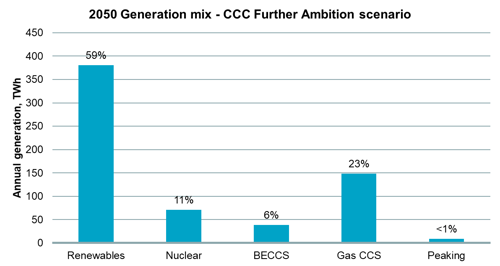
How feasible is the CCC’s Future Ambition scenario?
The question is how feasible is this scenario? To understand this LCP has created a more detailed capacity and generation mix that is consistent with these assumptions while making one change to the CCC assumptions.
Our analysis shows that, accounting for the intermittency of renewable generation, the CCC report implies a gas CCS capacity requirement of 70GW. This would require almost 3GW of new capacity to be deployed per year, assuming deployment started as early as 2025. We limited gas CCS build to 50GW to be more realistic considering the ambitious build rate with 16GW of baseload nuclear capacity providing the remainder of the 23% of total generation required.
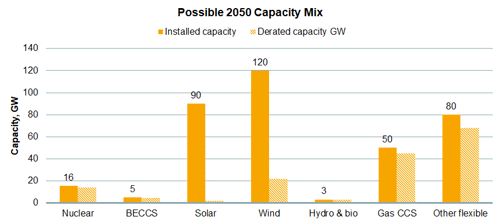
To provide 59% of generation from renewables, we estimate that over 200GW of renewable capacity is likely to be required, made up of predominantly wind and solar. The 80GW of “other flexible” would predominantly be made up of the backup gas plant envisaged in the CCC scenario, but would also include other technologies such as interconnection and battery storage. The resulting generation mix is shown below.
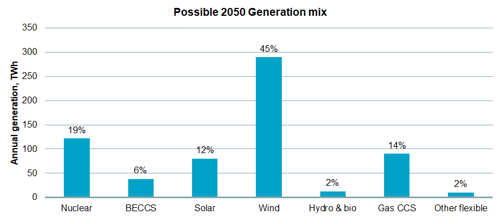
So how does a market like this operate? For one thing there is a significant amount of renewable curtailment implied by this modelling. To illustrate this, we can look at one extreme day where low demand is combined with high renewable output. We can see the high levels of curtailment required, with over 120GW of renewable generation needing to be contained. The sample day used is 7th August 2016 with the values increased to match the CCC’s 2050 scenario.
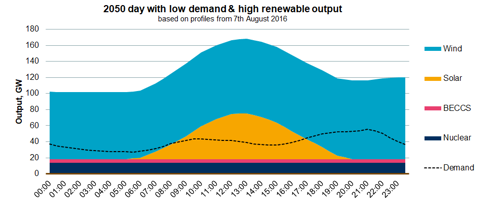
At the other end of the spectrum, we can also see the need for the high levels of backup capacity. Pulling out an extreme day of high demand and low renewable output, we can see that there is a small amount of unserved energy, despite the 80GW of flexible backup capacity and 50GW of gas CCS. The sample day used is 19th January 2016 with the CCC’s peak demand (close to the 150GW peak) used to show a day of extreme high demand.
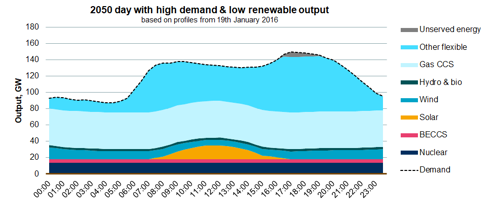
These extreme days, with very high levels of renewable curtailment and utilisation of vast quantities of backup generation, illustrate the potential benefits that long-term storage could provide. There’s no doubt the level of change that needs to be delivered is challenging but also necessary. The UK needs to decarbonise its economy and putting the right tools in place now will allow us to reach these ambitions in the most efficient way.

